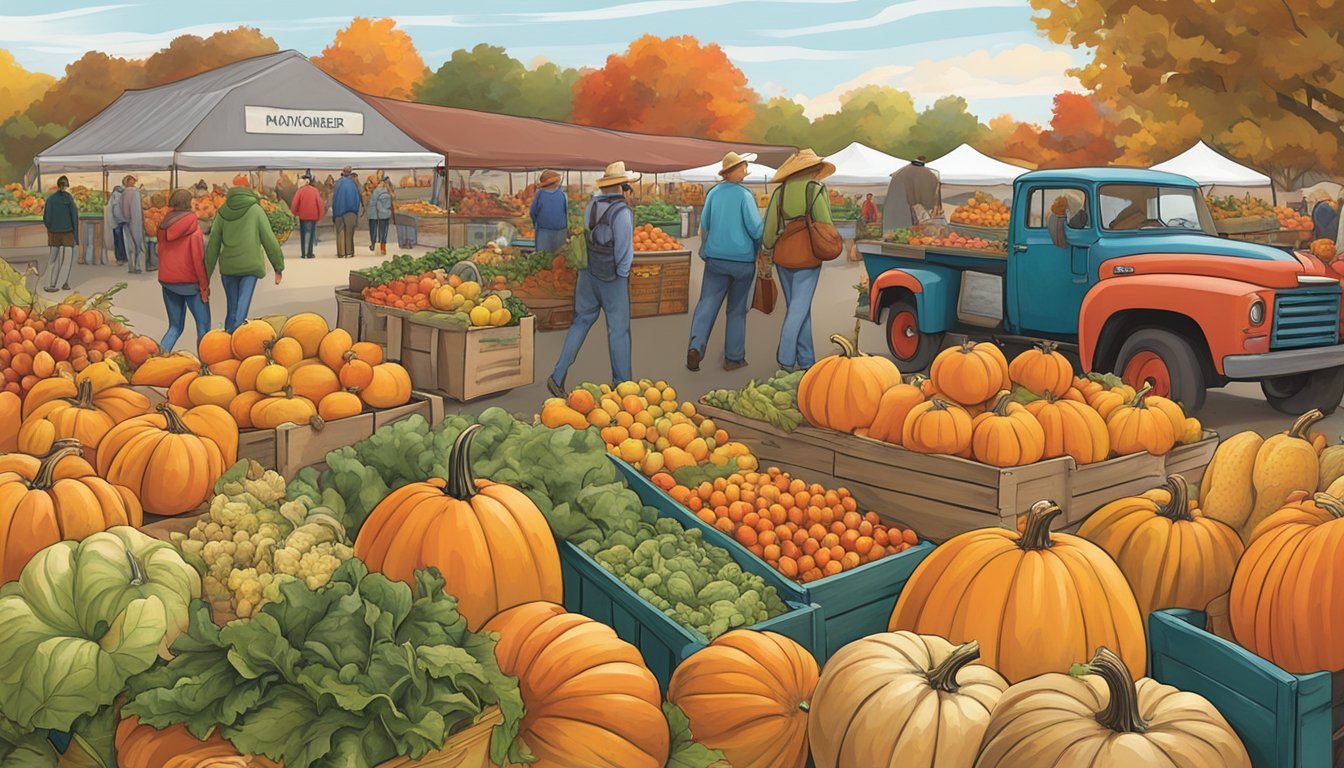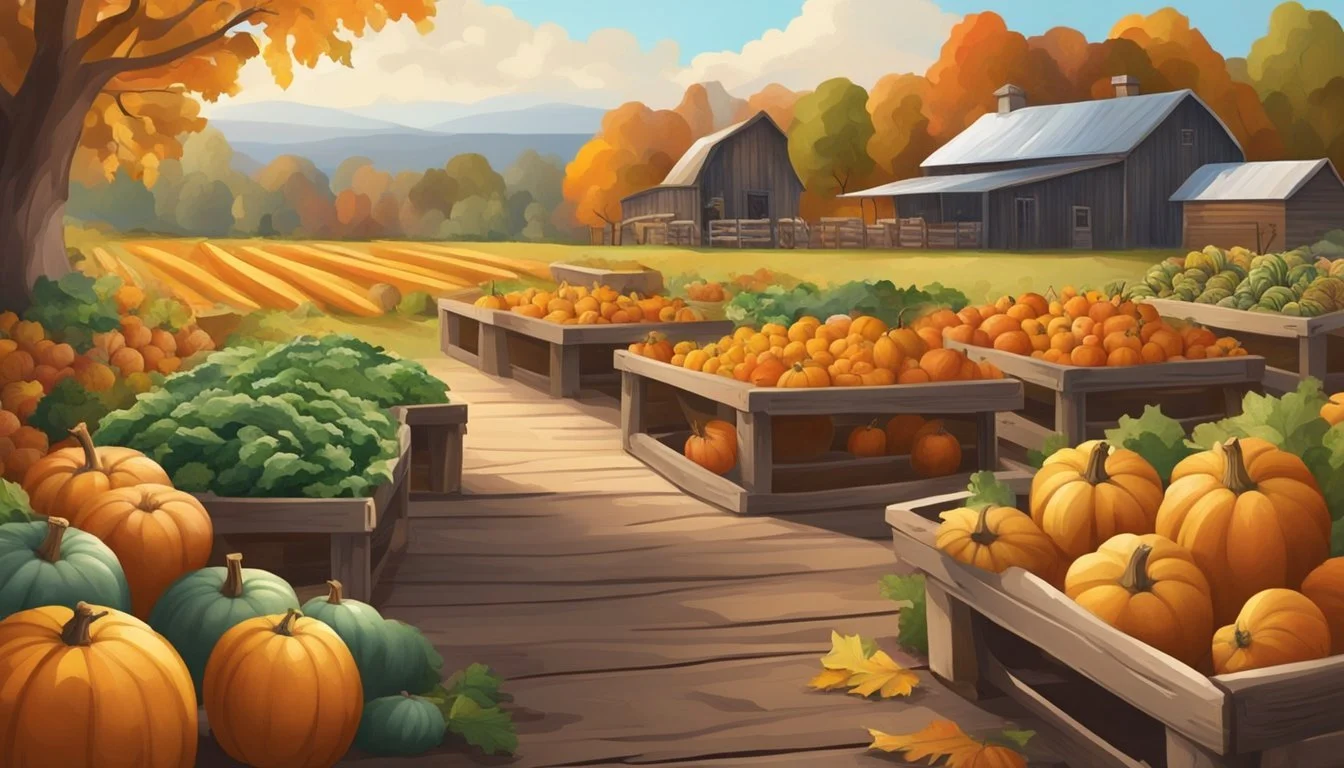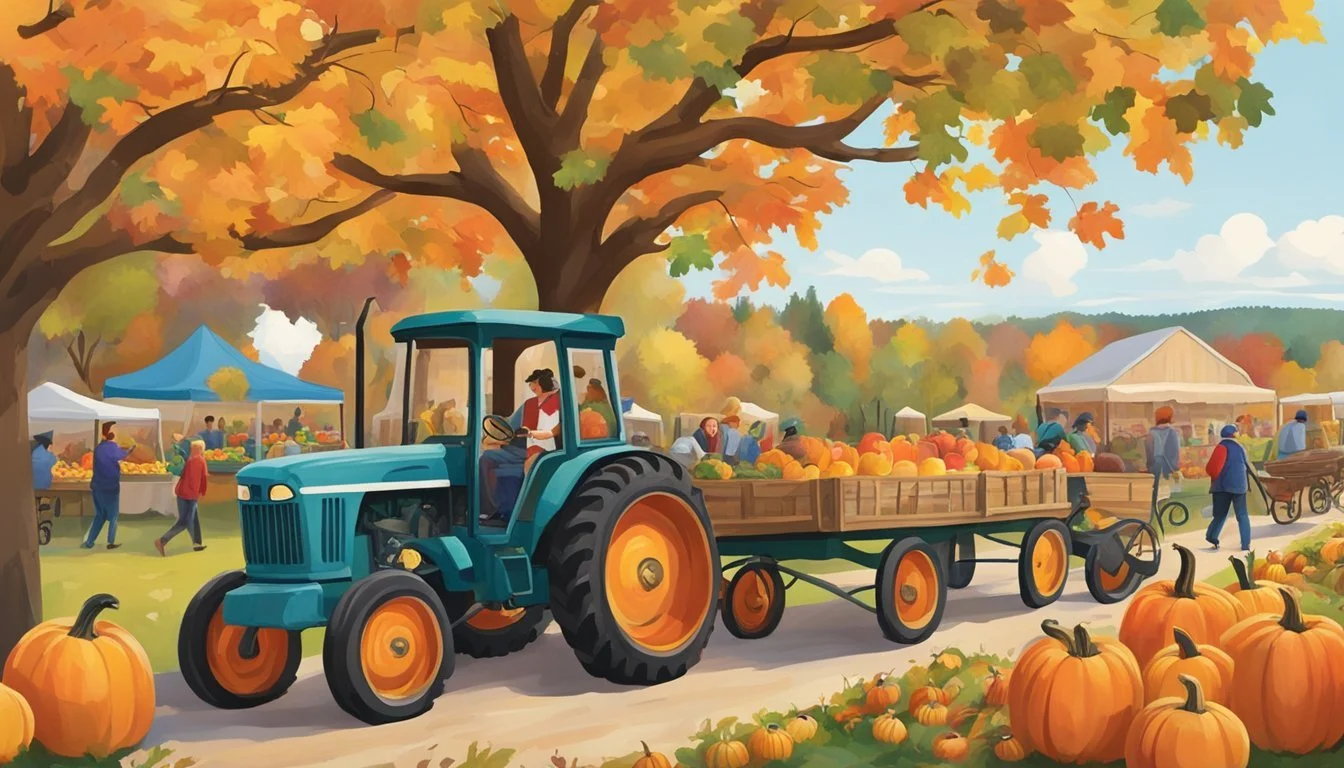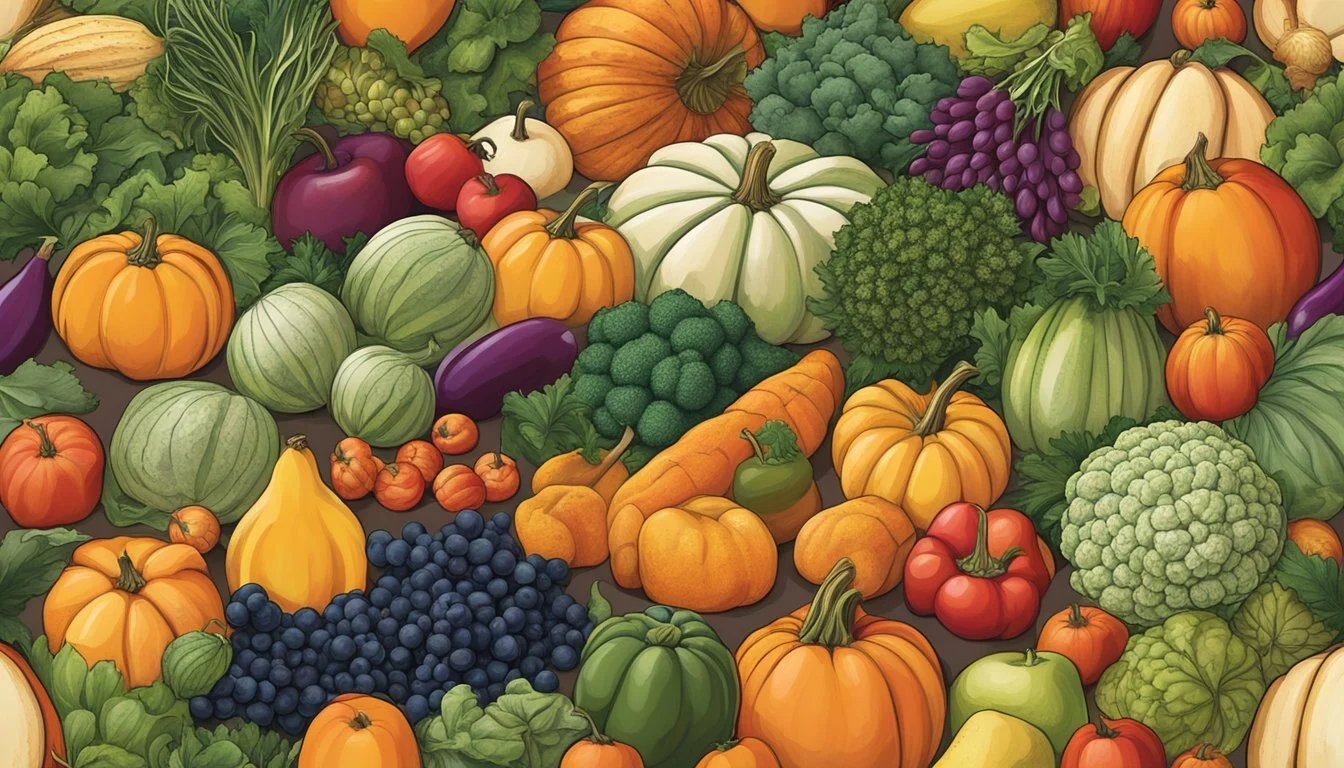Iowa Seasonal Fruit & Vegetables in November
A Guide to Fresh Picks
This Article is Part of our Iowa Seasonal Fruit & Veg Calendar
As November unfolds in Iowa, the agricultural focus shifts from the state's eminent summer crops to the heartier produce that withstands the cooler temperatures. Iowa's rich soil and diverse climate support a range of fruits and vegetables, but November marks a transitional period where the harvest calendar begins to favor late-season crops. During this month, the fields and markets transition, offering seasonal produce well-suited for heartwarming dishes and holiday feasts.
Root vegetables and hardy greens are prominent in Iowa's November produce lineup. They offer robust flavors and nutrition that cater to the culinary needs of the season. Farmers and home gardeners work through the chill to bring in crops such as sweet potatoes, (What wine goes well with potatoes?) parsnips, and winter squash, which are staples during this time of year. Moreover, as the last apples (how long do apples last?) are picked from the orchards, they too become an important part of the seasonal bounty, finding their way into various autumnal recipes.
Seasonal Overview of Iowa Produce
November in Iowa marks a period of transition where the late fall harvest gives way to the onset of winter. The month's cooler temperatures and shortened daylight hours influence the types of produce available.
Transitioning Seasons and Their Impact
As Iowa moves deeper into fall, the seasonal shift dramatically alters the agricultural landscape. While the growing season draws to a close, farmers and gardeners work to gather the last of the fall harvest before winter sets in. Produce such as squash and pumpkins are still available, benefiting from the late season's cooler conditions. Root vegetables, like turnips and parsnips, see an improvement in flavor after a frost, making them ideal for November harvests.
Harvest Timelines and Seasonal Shifts
Heading into November, Iowa's farmers adhere to specific timelines to maximize the quality and storage life of their produce. Below is a table highlighting some of the fruits and vegetables that are typically in their prime for harvest during this month:
In Season Produce Harvest Period Apples Late August - November Brussels Sprouts (how long do brussels sprouts last?)September - November Cabbage June - November Sweet Potatoes September - November Winter Squash August - November
It is essential to note that these timelines can vary due to environmental factors such as weather conditions and geographical location. Nonetheless, these crops thrive during the seasonal cusp between fall and winter, offering a bounty for Iowa's residents and markets.
Key Seasonal Fruits in Iowa for November
November in Iowa is a prime time for the robust flavors of late season fruits. This period offers an array of fresh, crisp apple varieties, a selection of late-fall berries, and some unique fruits that are ripe for picking.
Apple Varieties and Their Flavors
Honeycrisp: Sweet with a bit of tartness, very crisp
Fuji: Incredibly sweet, juicy, with firm texture
Braeburn: Balanced sweet and tart, firm to the bite
Granny Smith: Famous for its sharp tartness, crisp texture
Iowa orchards typically see these apple varieties reach their peak in November. Each variety offers distinct flavors and textures, suited for both fresh consumption and culinary uses.
Late-Fall Berries and Orchard Fruits
Cranberries: Vibrant, tart berries, perfect for sauces and baked goods
Pomegranates: Deep red fruits with tart-sweet arils, seeds surrounded by juicy pulp
Cranberries are often harvested in early fall but remain a staple throughout November. Pomegranates, not traditionally associated with Iowa, can also be found in some specialty farms or markets during this time.
Unique Seasonal Offerings
Persimmons: Sweet, honey-like flavor when fully ripe, often found in specialty markets
Persimmons are less common but can be sourced from local Iowa farms specializing in diverse produce. It's important to allow them to ripen fully to develop their characteristic sweetness.
The availability of these fruits can vary based on factors such as specific regional climates within Iowa and yearly weather conditions.
Principal Seasonal Vegetables in November
November in Iowa showcases a robust harvest of vegetables, with emphasis on nourishing cruciferous greens and hearty root vegetables. These staples offer versatility in dishes and nutritional benefits suitable for colder weather.
Cruciferous and Leafy Greens Harvest
In November, Iowa's fields are rich with cruciferous vegetables. This cool-weather group thrives in the state's climate, ensuring that vegetables like kale and Brussels sprouts are at peak freshness. These leafy greens are known for their health benefits, including high levels of vitamins and fiber.
Kale: A nutrient powerhouse, kale is versatile for both raw and cooked dishes.
Brussels sprouts: Best roasted or sautéed, these vegetables develop a nutty, sweet flavor when cooked.
Root Vegetables and Gourds Availability
As the cooler temperatures set in, the focus shifts to root vegetables and winter squash, both of which are staples in November.
Potatoes: With a multitude of varieties, they serve as a staple carbohydrate source.
Onions: Essential for flavoring a range of dishes and available in several varieties.
Turnips: Often mashed or roasted, turnips add a piquant flavor to autumn meals.
Winter Squash: Rich in vitamins A and C, winter squash encompasses varieties such as butternut and acorn, perfect for roasting or pureeing into soups.
These vegetables not only bring warmth and comfort to seasonal dishes but also provide essential nutrients during the colder days of November.
Local Produce and Farming Initiatives
In Iowa, November marks a transitional period for local produce, with the state's farming community embracing diverse initiatives to support agriculture. These initiatives bring fresh and locally grown food to the tables of Iowans through various programs and outreach efforts.
Community Supported Agriculture (CSA)
Many Iowans participate in Community Supported Agriculture (CSA) programs, where they pay for a share of a local farm's harvest in advance. In November, these shares typically include late-season crops like winter squash, potatoes, and hearty greens. Here's a breakdown of typical CSA features:
Shares: Weekly or bi-weekly distribution of vegetables, often with options for fruit, meat, and dairy.
Seasonality: Adapts to Iowa's harvest schedule, ensuring fresh produce.
Community Engagement: Connects consumers directly with growers, supporting local farms.
Iowa's Food Programs and Outreach
Iowa has several food programs and outreach initiatives that are especially active in November, aiming to increase access to wholesome, locally-grown food:
Local Foods - Practical Farmers of Iowa: This program includes produce, grains, legumes, dairy, and other locally produced commodities. They emphasize products made with at least 51% locally-sourced materials.
Iowa Produce Calendar: Provides a guide on when various produce is in season for optimal freshness.
Field to Family: Aims to link consumers with fresh, local produce through an online market and various interactive resources helping them meet growers like Wasson Produce.
These outreach programs not only promote the consumption of local produce but also strive to educate and establish a sense of connection between Iowa's residents and its agricultural foundations.
Preparing and Storing Seasonal Produce
When handling Iowa's seasonal produce in November, it is crucial to apply methods that efficiently preserve flavor and ensure prolonged storage. Different techniques like freezing, canning, and pickling not only extend the shelf life but also retain the taste and nutritional value of the fruits and vegetables.
Best Practices for Preserving Flavor
To preserve the natural taste of the produce, one should always start with fresh, high-quality fruits and vegetables. Blanching before freezing is advisable as it helps to maintain color, texture, and flavor. For root vegetables like beets and carrots, proper curing followed by storage in a cool, dark place can significantly enhance and preserve their sweetness.
Here are specific steps for flavor preservation:
Select Fresh Produce: Always choose produce at peak ripeness for the best flavor.
Clean Thoroughly: Wash fruits and vegetables under cold running water.
Pre-treat: For example, soak apple slices in a mixture of lemon juice and water to avoid browning.
Blanching: Briefly boil vegetables and then plunge them into ice water to halt cooking.
Freezing, Canning, and Pickling Techniques
Freezing is suitable for most vegetables and some fruits. Fruits best frozen include berries and apples, ideally in airtight containers or bags. Vegetables should be blanched first to stabilize enzymes that can lead to spoilage.
Canning provides longevity with acidic foods like tomatoes benefiting the most. One must follow established safety guidelines to prevent foodborne illness, using practices such as water bath or pressure canning based on the type of produce.
Pickling extends the life of vegetables like cucumbers and peppers. A solution of vinegar, water, and salt, often with added spices, creates an environment that preserves the produce and adds a tangy flavor.
Key considerations include:
Temperature: Store canned goods in a cool, dry area, and keep frozen goods at 0°F (-18°C) or below.
Containers: Use freezer-safe bags for freezing and sterilized jars for canning.
Labeling: Mark contents and dates for efficient inventory and usage.
Culinary Uses and Recipes
November brings a bounty of seasonal produce to Iowa, offering a range of culinary possibilities. The cooler weather inspires heartier dishes and the inclusion of fresh, late-autumn fruits in various recipes.
Seasonal Dishes and Flavors
Iowans take advantage of November's harvest by incorporating vegetables like Brussels sprouts, sweet potatoes, and root vegetables such as parsnips into warming dishes. Roasted Brussels sprouts with a hint of balsamic vinegar or baked sweet potato casserole topped with a crunchy layer of pecans are staples of the season. Root vegetables like parsnips and turnips can be roasted to enhance their sweetness or pureed into soups for a comforting meal.
Flavor Pairings:
Brussels Sprouts: Balsamic, garlic, bacon
Sweet Potatoes: Cinnamon, nutmeg (how long does nutmeg last?), maple syrup
Parsnips: Thyme, honey, mustard (how long does mustard last?)
Incorporating Fruits into Desserts
Late-autumn fruits such as cranberries, pomegranates, and kiwis are vibrant both in color and flavor, making them ideal for desserts. Cranberry pomegranate salsa served over cheesecake or a rustic apple-kiwi tart can be delightful endnotes to any meal. These fruits not only contribute to the visual appeal but also impart a fresh, tart taste that balances the sweetness of desserts.
Dessert Ideas:
Cranberry Pomegranate Salsa on Cheesecake
Apple-Kiwi Tart
Baked Pears with Honey & Pecans
Savory Vegetable-Inspired Meals
Savory meals in November often feature versatile vegetables like sweet potatoes and turnips. These vegetables can be the foundation of a wholesome vegetable hash or the base for a rich vegetable gratin. The robust flavors of these seasonal vegetables lend themselves well to herbed sweet potato black bean tacos or a creamy turnip mash as an alternative to traditional mashed potatoes.
Meal Components:
Vegetable Hash: Sweet potatoes, onions, peppers, eggs
Vegetable Gratin: Layered root vegetables, cheese, cream sauce
Sweet Potato Black Bean Tacos: Spiced sweet potatoes, black beans (how long do black beans last?), avocado, cilantro
Agricultural Events and Tourism
In November, Iowa's dedication to agriculture shines through various events and tourism opportunities focused on the state's seasonal produce. Visitors are encouraged to engage with the local community through farmers' markets and special farm-based events.
Farmers' Markets and Food Fairs
Farmers' Markets: Iowa’s farmers’ markets transition in November to showcase late harvest produce and artisanal goods. Shoppers can find:
Winter squashes
Hardy greens
Fresh baked goods
Food Fairs: Food fairs may feature:
Local preserves
Harvested honey
Crafted cheeses
These venues serve as prime destinations for experiencing Iowa's agricultural bounty firsthand.
Educational Farm Visits and Tours
Farm Tours: Farms often host tours in November, providing an in-depth look at crop harvesting techniques, winter preparation, and sustainable agriculture.
Demonstrations of fall harvesting methods
Discussions about seasonal crop rotations
Educational Visits: Schools and families can benefit from:
Guided educational visits
Hands-on activities to learn about food production
Educational visits often aim to connect the community with the source of their food during the harvest season.
Sustainability and Seasonal Eating
Seasonal eating in Iowa, specifically during November, brings multifaceted benefits including a lower environmental impact and bolstered local economy. The practice supports sustainability efforts and promotes community well-being.
Environmental Benefits of Seasonal Eating
When consumers choose seasonally available fruits and vegetables, they contribute to reduced greenhouse gas emissions. Produce that is in season is often grown within a closer geographic radius to its point of sale and consumption, minimizing the transportation distances and fossil fuel usage. Iowa's November offerings, such as squash and pumpkins, require less transportation when consumed locally, thereby reducing the carbon footprint associated with food miles.
In addition, seasonal produce is more likely to be cultivated using methods that are better aligned with the local ecology. This can lead to less reliance on artificial heating, cooling, and lighting, further conserving energy and reducing environmental strain. Moreover, seasonal crops usually demand fewer chemical interventions, such as pesticides and fertilizers, which are often used in off-season production to combat unsuitable climate conditions.
Supporting Local Economy and Farmers
Engaging in seasonal eating supports Iowa's local economy by channeling consumer spending to local farmers and producers. This practice empowers the agricultural community, allowing them to invest back into their operations and ultimately into better, more sustainable growing practices.
Purchasing seasonal produce also strengthens the community's economy as money spent on local produce is more likely to stay within the community and circulate among other businesses and services. Moreover, supporting local farmers can lead to a richer variety of produce, as small-scale growers are more likely to cultivate diverse and often heritage or heirloom species that are not usually found in large-scale commercial agriculture.
By opting for seasonal fruits and vegetables, consumers validate and encourage local agricultural knowledge and heritage, laying the foundations for an enduring local food system. This system not only preserves the environment and bolsters the economy but also contributes to the social sustainability of the community, maintaining a bond between the land and its people.










